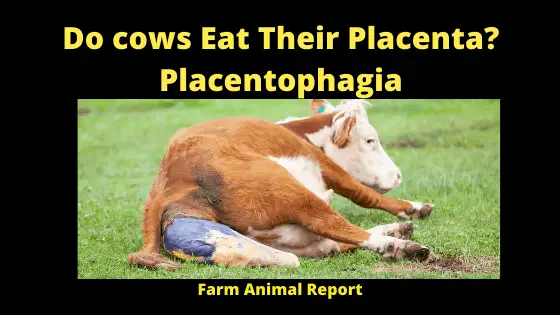Do Cows Eat Their Afterbirth / Placenta. Cows may eat their afterbirth, placenta, for several important reasons, some of the major theories that are put forth are:
- Nutrition
- Mother Nature
- Protecting from Predators – Wolves – Lions – Bears
- Bonding with Her Calf
Yes, Yes Cows will eat their afterbirth. . If a cow does eat her placenta, this act is known as placentophagia. It’s observed in many placental animals, including cows.
Do Cows Eat Their Placenta / Why / 3 Suggestions
There is no single, definitive reason known for why does a cow eat her placenta but in searching for the answer you come across four main theories:
After taking a closer look at the possible reasons why does a cow eat her placenta we contacted several producers to discuss what is done with the placenta on the farm and if placentophagia has ever caused any problems.
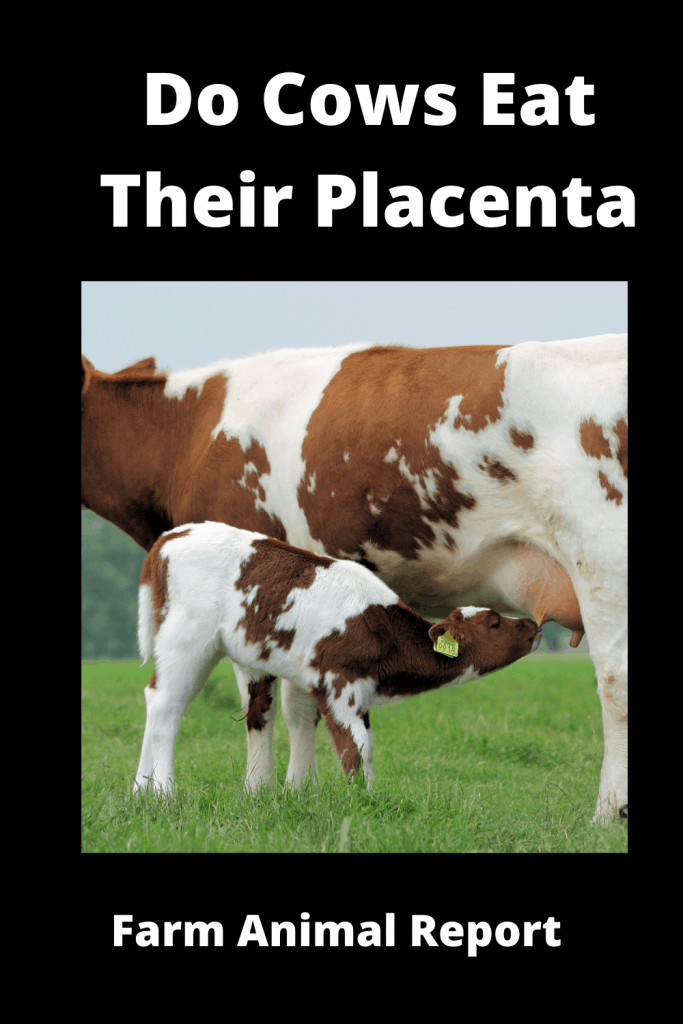
1. Bonding:
The idea that a cow eats her placenta as a means of bonding with her calf can probably be rejected. The placenta is released a few minutes to a few hours after the calf is born and it is not usually in contact with the calf. The idea of bonding may have arisen from confusing amniotic fluid in which the newborn calf is covered with the placenta.
See Amazons Educational Resources for Cattle Diseases
Most cows will pay attention to the calf while eating their placenta. But some become focused on the placenta and ignore the calf. In these cases, removing the placenta causes the cow to return her attention to her calf. This, in conjunction with the fact that the placenta is generally not in contact with the calf, opposes the idea of bonding as a reason for cows to eat their placenta.
See Our Guide – Ways to Make Money Cattle Farming
2. Hunger:
The second theory, which is known as hunger, is divided into two categories:
- General hunger
- Specific hunger
Widespread hunger:
Global hunger indicates that the cow is just plain hungry after calving. The fact that the placenta is edible, and generally near the calf, makes it a convenient meal.
Specific hunger:
Specific hunger refers to a craving. This theory suggests that there may be something in the placenta, for example, nutrients or hormones, that the cow craves postpartum. When asked if he had ever encountered a problem as a result of a cow eating her placenta, some people say that they had never encountered any problems. Still, some people believe that eating the placenta relaxes the cow and is good for the cow. If we take into consideration the belief that placentophagia in cows may be beneficial to their psychological health and specific hunger may help them to obtain this benefit.
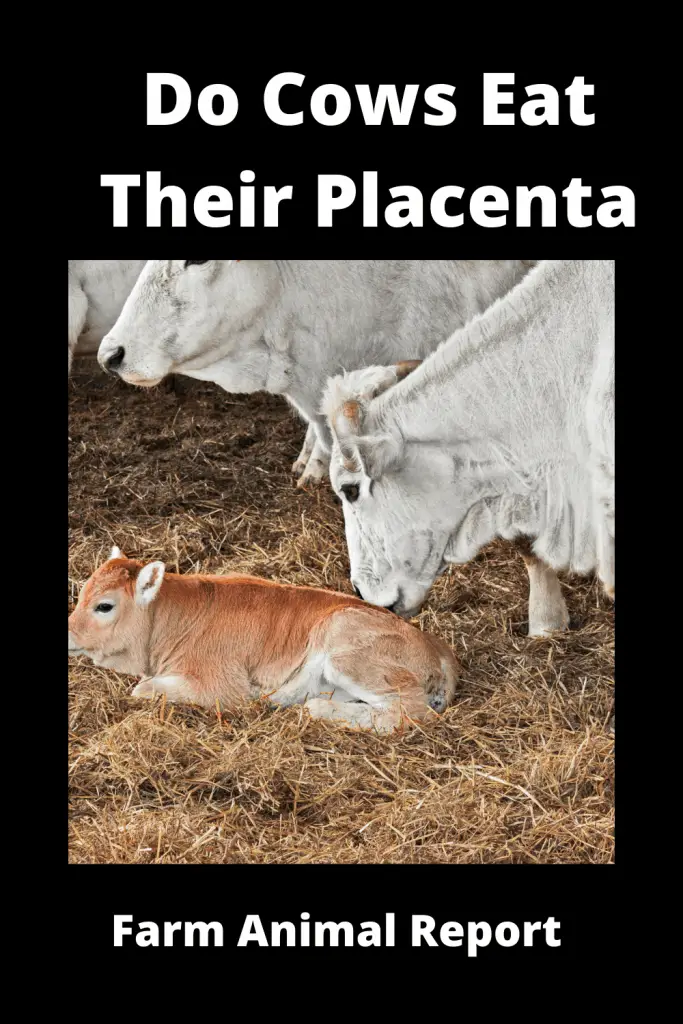
3. Predator Avoidance:
The third and most popular theory for why cows eat their placenta is predator avoidance. It was admitted that it is not a definite reason but describes it as a defensive mechanism to ensure that there is no evidence of the birthing to protect against predators.
The idea is that the cow eats her placenta so that the smell does not attract predators towards her and her very vulnerable calf.
Mother Nature / Instinct
The final theory concerning why cows eat their placenta, instinct, is mostly self-explanatory. They just do it, and it’s instinctive. Remember, cows were not always domesticated, and it is a
fact that virtually all placental mammals eat their placenta except for camels, cetaceans, and pinnipeds order of semi-aquatic mammals, including seals.
Cows Eating their Placenta are not Unique among Placental Mammals.
A possible side effect of the eating placenta:
- There is some space research out there on the effects of the placenta on cow health.
- A study that results showed increased feed intake after consuming placenta. This abstract of the study does say it has little to no effect on the health of the cow.
- Another possible side effect could be digestive turmoil. But no cow is having digestive problems. There is little research that has been done on this topic. Cows are smart creatures. They are selective eaters and great mothers. If you can trust the cow’s instinct, you can trust that eating her placenta is the right thing she can do.
Survey about the removing of placenta of cow versus other livestock:
There will be a study in which they corresponded with16 livestock producers to discuss reasons for leaving or removing the placenta and potential problems resulting from allowing placentophagia.
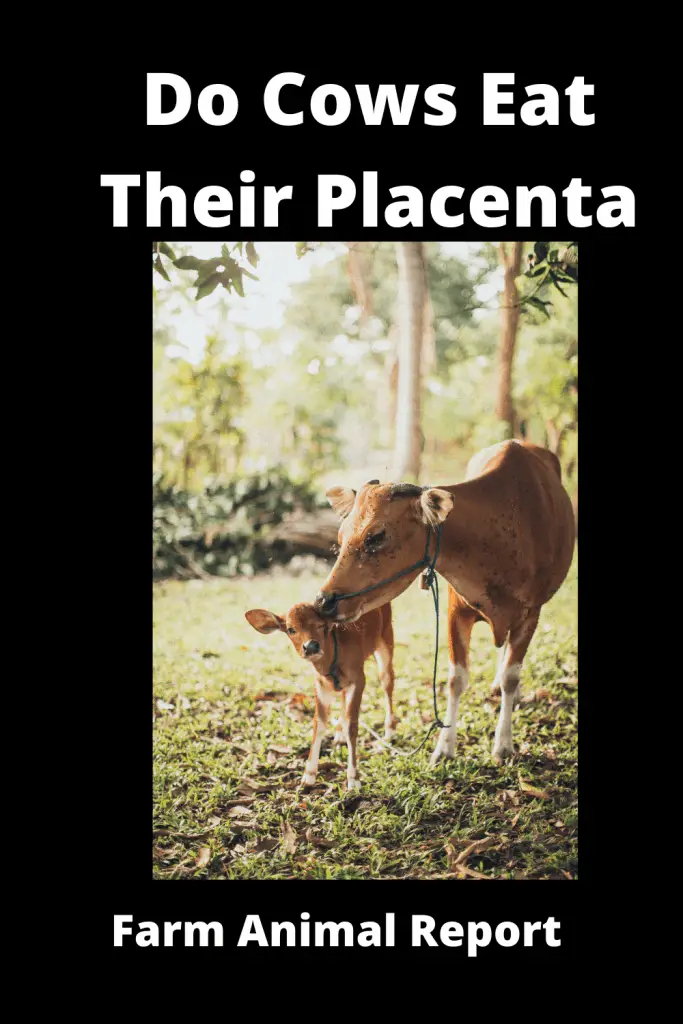
Compared with 17% of cattle producers who said they remove the placenta, 43% of other livestock producers said they removed the placenta; both for similar reasons. Overall, 11 % of the producers indicated that they leave the placenta to be eaten for the reasons including nutritional value, because it is natural for the animal, and because it is impractical to remove. The five producers who do remove the placenta said that they are doing so either to prevent attracting predators, prevent the animal from choking and promote cleanliness and sanitation in the birthing area. Over 80% of the producers indicated that they have never encountered a problem as a direct result of an animal consuming her placenta. However, the reminder indicated encountering problems involving animals choking. In two of these cases, nothing came of the choking, it either righted itself, or the producer was there to assist the animal; in the third case, two animals chocked to death.
Weighing the costs and benefits of allowing a cow to eat her placenta comes down to the producer’s situation and experiences. In free-range operations, for example, it may not be practical to be out monitoring every calving to remove the placenta.
It says that there may be some minor nutritional value, including proteins in the placenta, but the cow will survive well without eating it. So for those who are choosing to and able to regularly remove the placenta, there are no detrimental effects associated with disallowing placentophygia.
So, why do cows eat their placenta? By eliminating bonding as a possible reason we have narrowed it down to three main theories; hunger, predator avoidance, and instinct. Each has its appeal, and all seem own appeal not only as a reason for cows but also for why other mammals eat their placenta.
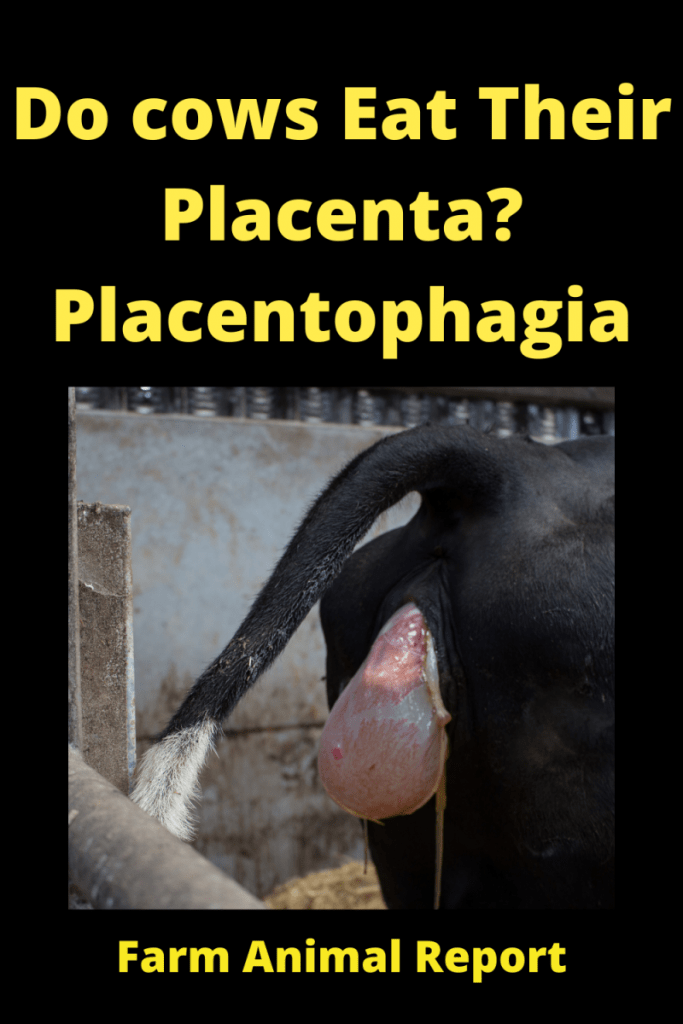
If the cow does not remove her placenta, then this is known as the retention of the placenta (ROP).
What is the Retention of the Placenta (ROP):
Retention of fetal membranes, or retained placenta, usually is defined as the failure to expel fetal membranes within 24 hours after parturition. Normally, expulsion occurs within 3-8 hours after calf delivery.
The incidence of healthy dairy cows is 5-15%, whereas the incidence in beef cows is lower. The incidence is increased by abortion (particularly with brucellosis or mycotic abortion), dystocia, twin birth, stillbirth, hypocalcemia, high environmental temperature, advancing age of the cow, premature birth or indication of parturition, placentitis, and nutritional disturbances. Cows with retained fetal membranes are at increased risk of metritis, displaced abomasums, and mastitis.
How Does the Retention of Placenta occur?
Retention of fetal membranes is mediated by impaired migration of neutrophils to the placental interface in the periparturient period. The impaired neutrophil function extends into the postpartum period and probably mediates the recognized complications of retained fetal membranes.
Cows with retained fetal membranes have increased cortisol and decreased estradiol concentration in late pregnancy. They may also have an altered prostaglandin (PG) E2: PGF2 ratio. Uterine contractility is increased in affected cows.
How Can you Diagnose that a Cow is Suffering from Retention of the Placenta?
Diagnosis is usually straightforward as degenerating, discolored, ultimately fetid membranes are seen hanging from the vulva greater than 24 hours after parturition. Occasionally, the retained membranes may remain within the uterus and be readily apparent, in which case a foul-smelling discharge may signal their presence. In most cases, there are no signs of systemic illness. When systemic signs are seen, they are related to toxemia. Uncomplicated retention of fetal membranes is unsightly and inconvenient for animal handlers and milkers but generally not directly harmful to the cow. However, cows with retained fetal membranes are at increased risk of developing metritis, ketosis, mastitis, and even abortion in a subsequent pregnancy. Cows that have once had retained fetal membranes are at risk of recurrence at subsequent parturition.
How Can We Treat the Retention of Placenta in cow?
The goal of an ideal therapy of retained fetal membranes would hasten the separation of the placenta and its expulsion from the uterine cavity as well as eliminate the bacterial contamination of the uterus. So far, however, a truly successful therapy has not been identified.
1. Manual removal of the membranes:
Manual removal had been a common practice in the past. This method should not be used because of possible injury to the endometrium and uterine cervix. Moreover, there is little evidence that such a practice produces any beneficial effect.
2. Hormonal Therapy:
Although occasional reports exist, in general, immediate postpartum administration of PGF2alpha, oxytocin or calcium generally have low efficacy in preventing the retained placenta or hastening the separation and expulsion of retained fetal membranes.
3. Anti-infective Therapy:
Generally saying the dominant approach to the retained placenta in cattle in the field condition is to administer locally or systemically antibiotics. Several studies indicate that approx. 50-80% of cows with retained fetal membranes exhibit elevated body temperature, which is greater than 39 degrees for at least 1 d within 10d pp. It is not clear whether all such animals indeed would need a systemic treatment with antibiotics.
4. Intrauterine Antibiotics:
Intrauterine antibiotics used in the treatment of retained placenta should have high activity against E.coli and be free of irritating properties. On many farms, all cows with a rectal temperature equal to or greater than 39.5 degrees C within the first ten days post-calving receive systemic antibiotic treatment.
There is the number of reports indicating the advantage of either intrauterine or systemic treatment but also some that demonstrated comparable efficacy of either of the approaches. It was stressed that at present, it seems economically preferable to selectively treat metritis cases rather than automatically treat all cows with retained placenta with antibiotics.
5. Homoeopathic Products:
Some products are through to improve contractility of the uterine muscle and intensify the blood flow in the endometrium. Unfortunately little is know of their real efficacy.
Prevention From Retained Placenta? ROP
Recent discoveries indicate that the retention of fetal membranes is associated with decreased immunity.
Retention of the Placenta due to the Metabolic Disease.
Retention of the placenta may be occurred due to the metabolic disease due to this way metabolic disease impair the uterine immunity. The mean immunity of the animal becomes a loss, and that’s why retention of the placenta may occur.
How Can you Prevent Your Cow if this has been Occurred Due to the Metabolic Disease?
You should give proper nutrition to your cow from the prevention of the retention of the placenta in the cow. Proper nutrition means give proper feed to the animal.
Vitamin E and Minerals Deficiency may Cause Retention of the Placenta:
Due to vitamin E and mineral deficiency impair the body’s immunity against the disease. So when the immunity becomes low, then it will cause the retention of the placenta in the cow.
How to Prevent this Deficiency from Preventing the Cow from the ROP?
Give vitamin E and mineral mixture to your cow before calving. The dose rate of the mineral mixture should be 100gm per day per animal as recommended. The mineral mixture contains all kinds of minerals, but the most important mineral in the reproductive point of view is selenium.
Retention of the Placenta may Occur Due to Infectious Disease:
Different kinds of infectious agents may cause the retention of the placenta. This infectious agent will be bacteria, viruses, or fungus. These will impair the body immunity in the cow. It will boost the retention of the placenta.
How Can you Prevent your Cow from Retention of the Placenta?
Proper vaccination should be given to your cow. Due to this way, animals become immunized against this infectious agent before entering the infectious agent into the body.
Cattle Losses 2010
| Cause of Death | Percentage of Total |
|---|---|
| Respiratory Problems | 26% |
| Unknown Reasons | 18% |
| Digestive Problems | 13% |
| Birth Problems/Calving | 12% |
| Weather | 12% |
| Diseases | 5% |
| Lameness | 4% |
| Coyotes | 3% |
| Mastitis | 2% |
| Metabolic Problems | 2% |
| Carnivores | .9% |
| Poisoning | .9% |
| Domestic Dogs | .6% |
| Large Cats | .5% |
| Theft | .4% |
| Vultures | .3% |
| Wolves | .2% |
| Bears | .1% |
World Cattle Breeder Associations
| Cattle Association | Location | Link |
|---|---|---|
| National Cattleman's Beef Associations | United States | NCBA |
| United States Cattlemans Association | United States | USCA |
| Ohio Cattlemans Association | Ohio | OCA |
| American Angus Association | United States | AAA |
| United Kingdom Cattle Associations | UK | UKCA |
| Australia Cattle Associations | Australia | ACA |


